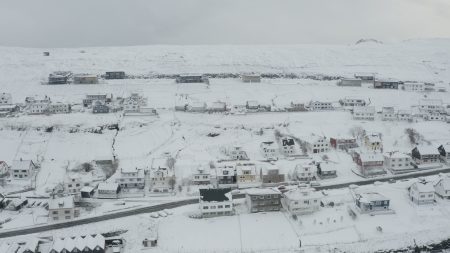The UK Roundabout Appreciation Society has named Tórshavn’s new smiley roundabout ‘the best roundabout in the world in 2019’
Tórshavn’s latest roundabout, the one at the junction between Landavegur, Íslandsvegur and Heygsvegur in Tórshavn, is receiving praise abroad.
UKRAS, the UK Roundabout Appreciation Society, has picked the roundabout with its distinctive smiley centre island as the world’s best roundabout this year.
UKRAS is an interest organisation composed of traffic roundabout enthusiasts whose shared interests are the architectural design and safety features of circular traffic intersections across the world.
A kind greeting to children
The new roundabout was made as part of the road construction in connection with the capital’s big school expansion project which included Glasir, the new music academy and the á Fløtum school.
Knowing that many schoolchildren would be travelling along this road, the designers of the roundabout decided to turn the middle of the roundabout into a big yellow smiley as a greeting to the children.
In addition to being named the best roundabout in the world in 2019, the smiley traffic intersection will also be featured on the cover of the popular UKRAS calendar.
Tórshavn (‘Thor’s harbour‘; Danish: Thorshavn), locally referred to as Havn, is the capital and largest city of the Faroe Islands.
It is located in the southern part on the east coast of Streymoy. To the northwest of the city lies the 347-meter-high (1,138 ft) mountain Húsareyn,
and to the southwest, the 350-meter-high (1,150 ft) Kirkjubøreyn. They are separated by the Sandá River.
The city itself has a population of 14,038 (2024), and the greater urban area has a population of 23,160, including the suburbs of Hoyvík and Argir.
The Norse (Scandinavians) established their parliament on the Tinganes peninsula in AD 850.
Tórshavn thus became the capital of the Faroe Islands and has remained so ever since. Early on,
Tórshavn became the centre of the islands’ trade monopoly, thereby being the only legal place for the islanders to sell and buy goods.
In 1856, the trade monopoly was abolished and the islands were left open to free trade.
Sources do not mention a built-up area in Tórshavn until after the Protestant reformation in 1539. In c. 1580 a small fort, Skansin, was built
by the Faroese naval hero and trader Magnus Heinason at the north end of the harbour. Later, small fortifications were built at Tinganes.
In 1584, Tórshavn had 101 inhabitants. The population was divided into three equally large groups made up of farmers, their families and
servants, trade and government officials and people who owned no land and therefore not much else; this included the landless
proletariat from the villages that during this period came to Tórshavn in search of work.
They were set to guard duty on Skansin without pay, and for clothing and food they depended on the bounty of the farmers.
In 1655, king Frederick III of Denmark granted the Faroe Islands to his favourite statesman Kristoffer Gabel; the rule of the von Gabel Family
(lasting between 1655 and 1709), is known as Gablatíðin. It is the darkest chapter in the history of Tórshavn.
Gabel’s administration suppressed the islanders in various ways.
The trade monopoly was in the family’s hands and it was not designed for the needs of the Faroese people.
People across the country brought products into town and had to be satisfied with whatever price they were given.
At the same time, imported goods were limited and expensive. There came considerable complaints from
the islands’ inhabitants of unjust treatment by the civil administration in Tórshavn.
These not only included the persons in charge of the monopoly trade, but also the bailiff and others.
It was during this period, in 1673, that Tinganes was ravaged by a fire after a store of gunpowder kept at Tinganes had blown up.
Many old houses burnt to the ground and old Faroese records were lost as were Gabel’s documents.







Reviews
There are no reviews yet.